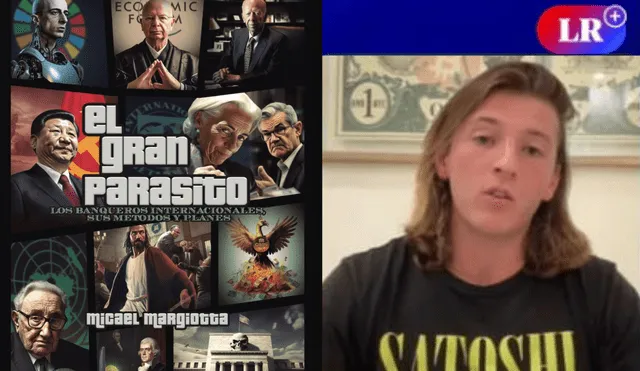The Great Parasite and Bitcoin: The Prophecy Margiotta Warned About Is Now Unfolding
As the IMF pressures countries like El Salvador, the U.S. is quietly integrating Bitcoin into its economy, reflecting a battle between fiat money and decentralization.
- Bitcoin como alternativa a los impuestos: ¿pueden los Estados financiarse con minería de BTC?
- Minería de Bitcoin: cómo los Estados pueden “imprimir” dólares más baratos que la Reserva Federal

On March 7, 2025, President Donald Trump signed an executive order establishing a Strategic Bitcoin Reserve in the United States. Funded with Bitcoin seized from legal proceedings, this move marks a drastic shift in the country’s monetary policy and confirms many of the warnings Micael Margiotta outlined in The Great Parasite: the manipulation of money, the erosion of purchasing power, and the shift toward a financial system based on digital control—while Bitcoin stands as the solution.
As the Federal Reserve struggles to contain inflation and avoid a recession, Bitcoin continues to establish itself as the only truly scarce and decentralized form of money. What once seemed like a conspiracy theory is now an open battle between two colliding monetary models: a debt-based, manipulated financial system versus a decentralized, censorship-resistant alternative.
The Federal Reserve and the Dollar Crisis
Margiotta argues that the Federal Reserve is not an institution that protects economic stability but a mechanism designed to benefit a financial elite. The uncontrolled printing of fiat money has served to transfer wealth from citizens to the government and banks, while inflation has impoverished the general population.
Since the 2020 pandemic, the Fed has injected over $8 trillion into the economy, triggering the worst inflationary crisis in over 40 years. In 2025, the Federal Reserve Bank of Atlanta projects a possible economic contraction due to declining consumer spending and tariff uncertainty.
Bitcoin, in contrast, operates under a transparent and unchangeable monetary policy. Its fixed supply of 21 million coins prevents arbitrary devaluation and protects users from the collapse of the dollar. The U.S. government’s decision to include Bitcoin in its economic strategy is an implicit acknowledgment of its value as a strategic reserve asset.
The End of the Petrodollar and the Rise of Bitcoin
Since 1971, the dollar’s dominance has been sustained through the petrodollar system, which requires countries to purchase oil exclusively in U.S. dollars. Margiotta warned that this model was destined to collapse, as it was not backed by real value but by political agreements and economic pressure.
Recent events have confirmed his prediction. Since 2023, China, Russia, and Saudi Arabia have started trading oil in yuan, rubles, and gold, weakening global demand for the dollar. In response, the U.S. has taken an unexpected turn—adopting Bitcoin as a strategic asset rather than blindly defending the petrodollar.
Although Trump’s Strategic Bitcoin Reserve does not involve direct purchases with public funds, the decision to hold seized Bitcoin suggests the government recognizes its long-term value. The irony is clear: while the U.S. pressures other countries to limit Bitcoin adoption, it is now quietly integrating it into its own financial system.
CBDCs Halted, but Stablecoin Adoption Rises
Margiotta described central bank digital currencies (CBDCs) as the final phase of total financial control. These would allow governments to track every transaction, restrict access to money, and enforce limitations based on political criteria.
China has already implemented its digital yuan, linked to its social credit system. In the U.S., while the Biden administration explored the development of a CBDC, Trump’s return to power has halted those plans. Federal Reserve Chairman Jerome Powell has reaffirmed that the U.S. will not have a CBDC without congressional approval, effectively delaying its implementation.
However, instead of promoting the use of cash, the government has begun adopting stablecoins—digital tokens representing U.S. dollars on public blockchains. This enables the digitization of money without requiring an official CBDC. Companies like Circle and Tether, which issue stablecoins backed by dollars, have seen increasing adoption within the traditional financial system.
The strategy seems clear: while the U.S. officially halts CBDCs, it is pushing centralized tokens that serve the same purpose—without the label of a central bank digital currency. Meanwhile, Bitcoin remains the only truly decentralized alternative that escapes government control.
El Salvador and IMF Pressure
Margiotta predicted that smaller nations would be the first to challenge the global financial system, as they have less to lose and more to gain by adopting a decentralized model.
El Salvador has continued accumulating Bitcoin, increasing its reserves to over 6,102 BTC. Despite pressure from the International Monetary Fund (IMF), which conditioned a $1.4 billion loan on reducing Bitcoin’s status as legal tender, the Salvadoran government has continued purchasing Bitcoin for its treasury.
The IMF demanded that Bitcoin no longer be mandatory for tax payments and businesses, but the country has maintained its accumulation strategy. The paradox is that now the U.S. is following the same path—pressuring El Salvador to diminish Bitcoin’s role while storing Bitcoin in its own strategic reserve.
Bitcoin and the Collapse of the Fiat System
The predictions in The Great Parasite about the collapse of the debt-based financial system are coming true. The inflation crisis, the decline of the petrodollar, and the digitization of money indicate that the fiat model is reaching its limits.
Margiotta warned that during the transition to a new financial order, governments would attempt to control the process through digital asset regulation and economic surveillance systems. He also foresaw that Bitcoin would not only be adopted by individuals and companies but would eventually be accumulated by nation-states—just as the U.S. is now doing with its Strategic Bitcoin Reserve.
This confirms that the clash between the fiat system and Bitcoin is no longer a hypothesis but an evolving reality. The story Margiotta described in his book is unfolding, and its outcome will define the future of money in the coming decades.